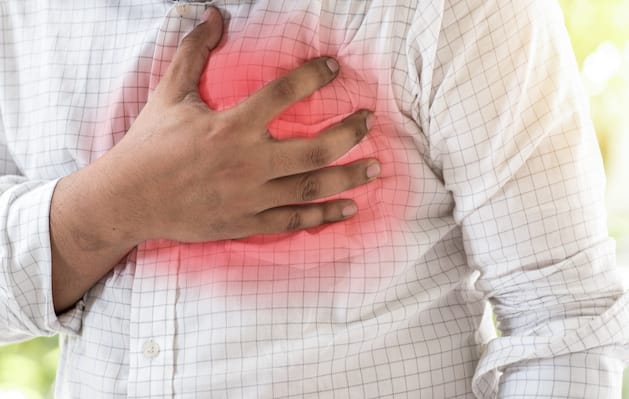Sad news from the USA. Singer Lisa Marie Presley, daughter of rock ‘n’ roll legend Elvis Presley, has died at the age of 54. Media reports of a cardiac arrest. In Germany, too, 65,000 people die of sudden cardiac death every year – what you have to do in an emergency.
The daughter of rock ‘n’ roll legend Elvis Presley, Lisa Marie Presley, is dead. The US singer died at the age of 54, her family said on Thursday (local time). According to the celebrity portal “TMZ”, Lisa Marie Presley was hospitalized at home after a cardiac arrest and put in an artificial coma. The 54-year-old was Elvis Presley’s only child. The exact background – including whether Presley may have suffered from a previous illness – is still unclear.
Suddenly the heart stops beating. Blood pressure drops to zero. Those affected feel an emptiness in their heads and collapse unconscious after about eight seconds. Breathing stops within two to three minutes – death occurs after about ten minutes. That’s how sad the facts about sudden cardiac death look, from which 65,000 people die every year in Germany alone.
As Dietrich Andresen, former CEO of the German Heart Foundation, explains, this is usually not a fateful event from which there is no escape: “Sudden cardiac death is usually a complication of a long-standing cardiovascular disease,” says the heart specialist. Those most at risk are those who suffer from it and don’t know anything about it.
Coronary artery disease, or CHD for short, is most common in people over 40. Autopsies on those who died suddenly showed that 75 percent had CAD. A frightening number, because experts estimate that around six million people are affected in Germany.
The reason: CHD often occurs as a result of other diseases such as high blood pressure, diabetes and lipid metabolism disorders such as high cholesterol.
But what exactly is behind coronary heart disease? According to the German Heart Foundation, this is a circulatory disorder in the heart muscle due to narrowing of the coronary arteries. These in turn lead to scarring of the heart muscles and thus promote cardiac arrhythmias. The disease also frequently causes cardiac insufficiency (cardiac insufficiency).
However, other diseases can also be the cause of sudden cardiac death – especially in people under 40. From heart muscle inflammation, which is caused by a delayed infection, i.e. bacteria and viruses, to congenital heart defects and genetic heart diseases.
This includes, for example, the so-called ion channel disease, an excitation disorder of the heart muscles. Another cause can also play a role in younger people in particular: the use of drugs such as cocaine and amphetamines.
The best strategy for protecting yourself from sudden cardiac death is prevention. It is important to recognize risk factors and diseases of the heart early enough. “We advise men and women over the age of 40 – who have a family history earlier – to have regular check-ups with their family doctor,” says Andresen. If this diagnoses a heart disease, it must be checked regularly by the cardiologist.
If it turns out to be a congenital heart defect, those affected should go to an ACHD cardiologist who specializes in adults with congenital heart defects (ACHD).
Certain symptoms may occur in the run-up to cardiac arrest.
You should look out for these warning signs:
If cardiac arrest occurs, people around the affected person must react quickly. Because the lack of oxygen transport causes organ damage within a few minutes – the brain is particularly affected. The German Heart Foundation recommends the following steps:
1. Check whether the person can be addressed! Shake her both shoulders and ask her name and what happened.
2. Check the mouth and nose to see if the person is still breathing. For this you should stretch the head of the unconscious person. Raking and gasping are typical of the first phase after cardiac arrest.
3. Call an 911 immediately if this happens.
4. Immediately begin chest compressions: Have the person lie on a hard surface. Kneel beside the person and place one hand on the center of the chest, the other hand over it, and squeeze the sternum in toward the spine about two to six inches in rapid succession—about 100 to 120 times per minute. Relieve pressure after each pressure and never interrupt the massage by breathing.
An example of the right timing is the song “Staying Alive” by the Bee Gees. Background: The cardiac massage creates a blood circulation and transports blood with oxygen to the brain – this can prevent thousands of brain cells from dying.
5. If you are alone with the affected person without other helpers, you have to carry out the massage until the rescue service arrives and under no circumstances interrupt it – this kills too many brain cells. If there are two of you, the other helper gets a defibrillator if there is one nearby. With the AED (automated external defibrillator), you then follow the instructions of the integrated speech module.
Read the issue of FOCUS-GESUNDHEIT what makes your heart strong and what you can do when it gets sick.
You can find pictures and videos of emergency help in the event of cardiac arrest and heart attack at www.herzstiftung.de/herznotfall-verhalten.html








